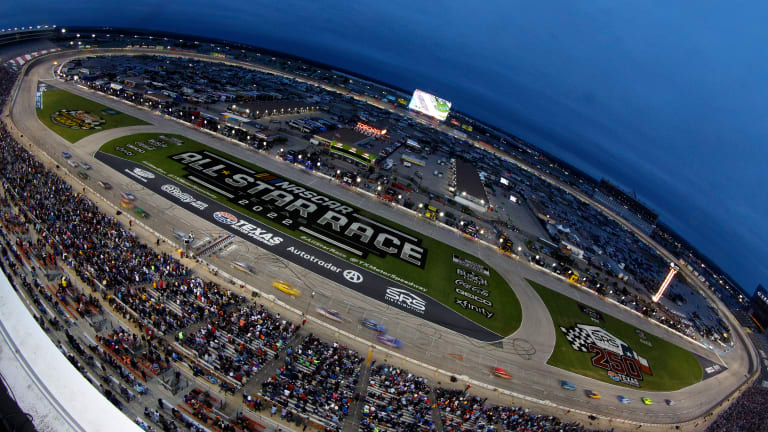
The eyes of Texas are upon Texas Motor Speedway and its future

“Demolish this place, first. Then, start over from scratch.”
Kyle Larson didn’t hold back when asked how he would improve Texas Motor Speedway. These weren’t the words of a driver speaking out of anger after having just crashed out of race – this was before Sunday’s debacle of a NASCAR playoff race, which saw car after car spinning out and bringing yet another caution flag.
It’s clear that this is a track that doesn’t work for the current NASCAR, at least in its current layout. Since it was reconfigured in 2017, track management has been trying to deal with the issue of cars being unable to race on the outside without rolling the dice on finding themselves losing control, usually ending up in the wall.
The inevitable culmination of the problem were the events of this past Sunday, where fans were given the opportunity to watch the short periods of racing at full speed that managed to be fit in between the 16 caution flags. The track has tried to look for a solution by applying traction compounds such as PJ1 and running their “tire dragon” to lay down rubber, but the general opinion on the results ranges from “useless” to “making the problem worse”.
There isn’t much agreement whether the blame for Sunday’s troubles can be put on track, tires, or teams, with many blaming Goodyear, and Goodyear blaming the teams' disregard for their air pressure guidance. But regardless of the issues with this one event, tire pressure can’t explain away four years of bad racing.
And for many fans, they’ve decided they have seen enough. While the drama of the playoffs has brought full grandstands to Darlington, Kansas and Bristol, the Texas race was noticeable for its empty seats and closed sections. And this despite the efforts of the facility to provide top-level amenities and service for fans, who praised the facility - except for the mile-and-a-half oval that sits in the center.
Mark Faber, who replaced Rob Ramage as general manager of the speedway one year after Ramage took over for long time boss Eddie Gossage, has got to be wondering exactly what kind of fire he’s been thrown into. The quest to create what can pass for acceptable stock car racing has also managed to ruin what had been an exciting IndyCar event, which despite the fact that tickets are sold as part of a yearly package with NASCAR, is now watched by mainly empty seats.
And IndyCar also serves as a warning – despite their drivers managing to pull off thrilling passes on perhaps 30-feet-wide of usable track, the fans haven’t been coming back.
Faber will in a way have less to worry about next year – the venue will host only one NASCAR race (although IndyCar is surprisingly coming back as well, even though many predicted it wouldn't) - but finding a way to stem the bleeding of attendance numbers is urgent, and no small challenge especially when that lone Cup race will be in the playoffs next September and will be going up against football season in Texas.
The Texas troubles have been a double black-eye for the series – in both the race and the attendance, especially when in less than a month from now, 150,000 fans will cram the Circuit of the Americas 225 miles away in Austin, Texas to watch Formula 1.
If this were happening anywhere else in the country, NASCAR would probably be thinking of pulling up stakes, but giving up on the most densely populated region of the South isn’t something they can realistically consider.
Since leaving isn’t in the cards, hopefully another quick fix isn’t either. Perhaps Larson’s suggestion of “tearing it down and starting from scratch” isn’t going to happen – but maybe he does have a point. The series needs to take its time and completely reimagine what the racing should look like, not simply adjusting the width and banking once again, even if it requires a project that looks several years into the future.
Might it consider what will eventually take place at Auto Club Speedway, which will be reimagined from its current two-mile facility to a high-banked, half-mile venue -- kind of like a Bristol Motor Speedway of the west coast? That same idea might potentially work at Texas.
But at the very least, NASCAR needs to get the ball rolling on fixing this mess quickly. If they think Goodyear (or another tire manufacturer) is going to solve this problem, they are very sadly mistaken.
One option would be to follow the lead of Atlanta and look to make it a tapered spacer (the replacement for restrictor plates) superspeedway, though that would come with the additional burden of many unhappy drivers, who don’t want to exchange the single car spinouts for multi-vehicle pile ups. While attendance didn’t look great in Year 1 at the “new” Atlanta, NASCAR can see if the positive fan reaction has resulted in strong ticket sales for 2023 and plot a course from there.
Whatever the proposed solution, the stakes are high. NASCAR is in an era of transformation, split between finding new types of venues, like next year’s Chicago street race, and a appreciation for the past, demonstrated by the revival of North Wilkesboro. The cookie-cutter tracks don’t belong to either. Texas needs to be part of the series' future, but will need to find a way to give the fans a better product if wants to be more than just the weekend on the schedule everyone dreads.